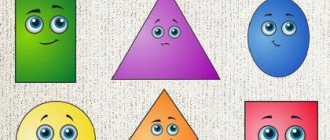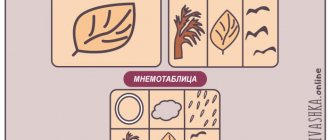The formation and active development of the level of coherent speech for preschoolers requires not only the increased attention of both parents, but also specialized classes that can be conducted in a playful or theatrical form, which is especially attractive to children. In the process of working with children, speech therapists and teachers use many modern techniques, among which mnemonics stands out, aimed at actively developing the level of coherent speech and memory in preschool children.
What is mnemonics
Mnemonics for increasing the level of speech development is a set of techniques aimed at improving perception with memorization of various information using sound samples and visual illustrations.
Provided that classes are carried out systematically, mnemonics for speech development allow you to:
- improve the memorization of heard texts in the form of stories, fairy tales, etc.;
- transform visually acquired data into abstract (and vice versa);
- create logical chains of events;
- Expand words knowledge;
- stimulate the development of imagination and thinking;
- develop children’s ability to compose complex sentences of a descriptive type, which include many words.
Mnemonics, as one of the most effective methods of memorization, is actively used not only by speech therapists, but also by teachers in kindergartens and other preschool institutions.
There are no age restrictions for classes, but many specialized experts recognize the age of 4-5 years as the most optimal, when children already have a fairly rich and varied stock of words and phrases that they can actively use.
The main tool that is used in mnemonics for developing the level of coherent speech in preschool children are mnemonic tables - specific diagrams in which certain information data is embedded.
Mnemonic diagrams for the little ones should be painted in bright shades so that the image that a frog is green, a chicken is yellow, etc. is imprinted in their minds.
For older children, it is preferable to use single-color schemes that do not distract attention, distracting them with additional, and often unnecessary, details.
Areas of use of mnemonic tables
Mnemonic tables for the formation and development of coherent speech (developmental and educational) are images of textual information that is previously divided into groups of words in sequential order. There is one illustration for each group of words. Thanks to such a schematic sketch of information, the baby easily perceives it, remembering everything without much effort.
Using mnemonic tables for speech development, the following is carried out:
- Memorizing fairy tales or rhymes. Young children take part with great interest in educational games based on fairy tales they know. At home, you can invite your child to tell a story to his favorite toy, using a series of pictures. You can also draw a mnemonic table together, depicting the heroes of events with your own invented symbols, for example, a triangle is a person, a wavy line is a cloud in the sky. Thus, not only the formation of coherent speech occurs, but also the active development of imagination and fantasy with the manifestation of the hidden creative abilities of children.
- Learning general rules, such as how to brush your teeth correctly. The diagrams depict the sequence of all manipulations that are easily perceived and remembered.
- Compiling stories describing objects, events, pets, etc. Focusing on pictures that answer basic questions: who is it, what color is it, what sounds does it make, what does it like to eat, etc., children can create a consistent description.
- Working on a retelling. After reading the text, the most difficult words are highlighted, the meaning of which must be explained to the child. After the explanations, a conversation should be held on the entire content of the text with a demonstration of drawings from the mnemonic table. A joint retelling using pictures will allow the child to quickly remember information and tell the story he heard himself.
- Solving riddles. With the help of mnemonic tables, children learn to identify an exact object, focusing on its characteristics. At the first stage, it is necessary to explain to the child everything that is depicted in each picture, and only after that offer to independently guess the encrypted object.
Speech therapy classes on the development of coherent speech using a variety of mnemonic diagrams involve memorizing and deciphering the plot illustrations given in the table. The type and thematic content of mnemonic tables can be different; execution can be printed (Doman cards) or made by hand. Cards for speech development in the first lessons should be small with light storylines; it is recommended to place 3-4 of them in one row, in this position they are easier to perceive.
Article Automation of sounds using mnemonics. Author: Novikova Natalya Vladimirovna
Municipal budget preschool educational
establishment of the Kiselevsky urban district kindergarten No. 13 of a combined type
Topic: “Automation of sounds using mnemonics”
Completed by: teacher-speech therapist
Novikova Natalya Vladimirovna
While working with children with various speech disorders, I encountered a problem that is very often observed in children with speech pathology. This problem lies in the long period of automation and differentiation of the delivered sounds. Preschoolers with speech impairments are not happy to participate in educational activities. As a rule, such children have memory impairments, reduced attention, mental processes are not as mobile, they do not show interest in search activities, and do not have high performance. For these and other reasons, children with speech disorders do not like to learn poetry, retell texts, and do not know memorization techniques. At the stage of automation of sounds in poetic texts, their self-control over speech decreases. Therefore, it is very important to awaken interest in activities in children with this pathology, to captivate them, and to liberate them.
As practice shows, the use of a mnemonic system allows you to speed up the process of automation and differentiation of delivered sounds, facilitates the memorization and subsequent reproduction of a complete image in rhymed form.
Mnemonics is a system of methods and techniques that ensure effective memorization, storage and reproduction of information.
The purpose of teaching mnemonics is the development of memory, thinking, imagination, attention, namely mental processes, since they are closely related to the full development of speech. This technique allows you to significantly reduce training time by optimizing and rationalizing the basic operations of mental activity. Using game moments allows you to master even complex material without mental or nervous stress. Exercises that connect the verbal and visual series (analyzers) contribute to the development of speech, memory, logical and figurative thinking.
The use of mnemonics for preschoolers today is becoming increasingly relevant, because in the modern world there is a lot of encoded information in the form of symbols and diagrams, and it is important to teach a child to recode information from symbols into images. In children with speech pathology, it is especially important to develop visual-figurative thinking, using symbols, substitutes, graphic analogies, and diagrams, which underlie the formation of artificial associations that facilitate memorization and increase memory capacity, which is the essence of mnemonics.
In correctional pedagogical work, mnemonics help in the development of:
• connected speech;
• associative thinking;
• visual and auditory memory;
• visual and auditory attention;
• imagination;
• accelerating the process of automation and differentiation of delivered sounds.
The essence of mnemonic schemes is as follows: for each word or small phrase a picture is invented; thus, the entire text is sketched schematically. Looking at these diagrams - drawings, the child can easily reproduce text information.
Like any correctional work, work on mnemonics must meet certain requirements and rules:
– signs and symbols used in mnemonic tables should be well known to children;
– signs and symbols must display a generalized image of the object;
– signs and symbols are previously discussed with children and accepted as leading ones;
– the concept of the graphic diagram should be familiar and understandable to the child.
Like any technique, mnemonics are built from simple to complex. It is necessary to start working with the simplest mnemonic squares, sequentially move on to mnemonic tracks and later - to mnemonic tables and collages.
A mnemonic track is a table of 4 or more cells arranged linearly. The mnemonic tracks were based on short proverbs and poems. At first glance, unrelated pictures are combined into one plot, with the help of which signal schematic images help to activate mental and mnestic processes.
A mnemonic table is a diagram that contains certain information. It is divided into 6.9 or more parts (taking into account the age of children and their level of development) and is used when telling fairy tales, composing stories, memorizing and reproducing poems, performing finger and articulation gymnastics, consolidating algorithms for performing routine processes, etc.
Types of mnemonic tables:
• Developmental (training of basic mental processes)
• Educational.
Mnemonic tables can be subject-specific, subject-schematic and schematic. If the children have mastered the subject model, then the task becomes more complicated: they are given a subject-based schematic model. This type of mnemonic table includes a smaller number of images. And only after this a schematic mnemonic table is given.
Collage - (from the French collage - gluing). This is an image based on the unexpected combination of dissimilar materials. In mnemonics, this is a sheet of cardboard (thick paper or flannelgraph), onto which various pictures, letters, geometric shapes, and numbers are pasted or superimposed (drawn). The apparent chaos of pictures superimposed on cardboard is the essence of the collage. Mnemonic collage is used to reinforce various memorization methods; development of a child’s photographic memory; expansion of vocabulary, figurative perception; development of oral speech, the ability to speak coherently and tell stories.
When working with mnemonic tables, you must follow the following steps:
1. Examination of the table and analysis of what is shown on it.
2. Recoding of information, i.e. converting symbols into images.
3. Reproduction of information (fairy tales, stories, poems) based on symbols (images), maintaining consistency, i.e. practicing the memorization method.
4. Graphic sketch of the mnemonic table.
When forming correct sound pronunciation, mnemonics can be used at all stages of correction work, since mnemonics are multifunctional.
At the stage of evoking and staging an isolated sound, this can be a drawn or schematic graphic image of a sound that helps the child remember the correct articulatory pattern and acoustic sound of the sound. As the work becomes more complex (automation of sound), the image of the sound becomes more complex; this is already a certain scheme (set) of signs and symbols. The number of characters depends on the individual abilities of the child and the stage of work.
Work on developing the correct pronunciation of sounds using mnemonics includes the following:
Block 1 (stage of evoking and staging sound) – coming up with an image of sound and its correlation with the graphic-pictorial model;
Block 2 (sound automation) – correct pronunciation of sounds using several graphic-picture models of sounds and words;
Block 3 (introduction of sound into speech) – creation of graphic-picture models of sentences, stories, poems.
Mnemonics uses the natural memory mechanisms of the brain and allows you to fully control the process of memorizing, storing and recalling information. The memorization process is divided into four stages:
encoding elements of information into visual images;
the actual process of memorization;
remembering a sequence of information;
consolidation of information in memory.
It is important to note that the ability to remember does not depend primarily on memory, but on thinking and attention. Disturbances in the functioning of these mental processes will make voluntary memorization almost impossible.
In children with speech pathology, it is especially important to develop visual-figurative thinking, using symbols, substitutes, graphic analogies, and diagrams, which underlie the formation of artificial associations that facilitate memorization and increase memory capacity, which is the essence of mnemonics. After all, it is symbols and signs that form the basis of sound-letter analysis of words and mathematical concepts. Reliance on a visual image is important and mandatory, since if, when reproducing a text, this visual image does not appear in the imagination, then the child does not understand this text.
In correctional work on automating sounds, small poetic texts or riddles are selected to automate a certain sound or differentiate sounds. Then, using simple and understandable symbols for the child, mnemonic tables are drawn.
When working on memorizing poetic texts using mnemonic tables, you must follow the following sequence:
1. Expressive reading of a poem.
2. Setting to remember. Then reading a poem based on a mnemonic table.
3. Questions about the content of the poem, helping children understand the main idea.
4. Explanation of the meaning of unclear words in a form accessible to children.
5. Repeated reading with a focus on memorization.
6. Reading separately each line of the poem based on a mnemonic table.
7. Reading a poem based on a mnemonic table.
When retelling texts, work based on mnemonic tables is carried out in the following sequence: reading the story, looking at the mnemonic table, reading the story a second time using the mnemonic table with the goal of retelling.
It is very convenient to work with such tables; children memorize texts with pleasure. The stage of automating sounds is much more interesting, and the effectiveness of correctional work increases, because The volume of visual and verbal memory increases, the distribution and stability of attention improves, and the mental activity of children is activated.
The use of a mnemonic system allows you to speed up the process of automation and differentiation of delivered sounds, facilitate memorization and subsequent reproduction of a complete image in rhymed form.
How to create mnemonic tables
Drawing up mnemonic tables involves performing the following manipulations:
- breaking the text into parts (focusing on the most important points);
- dividing a sheet of paper into squares (the number of squares depends on the highlighted parts of the story);
- depiction of each moment in the picture (both nouns and adjectives can be described);
- words that are difficult to sketch (verbs or questions) can be depicted as a “?” (the child must comment on them).
To facilitate the perception of fairy tales or riddles by young children, the works are broken down into individual situations, which are subsequently transferred to pictures for children.
Features of use
When practicing in the form of a game with mnemonic tables, children are asked to:
- review speech therapy cards;
- remember what is described;
- talk about what you saw, focusing on the pictures.
When children use mnemonics and perform assigned tasks, they actively carry out the following processes:
- viewing diagrams and understanding what you see;
- transformation of visual data into figurative data, identification of what is seen with a concept;
- compiling a story based on drawings;
- memorizing fairy tales, stories, etc.
Older preschoolers can themselves take part in compiling mnemonic tables, focusing on the words of the teacher, who broke the story (fairy tale, riddle) into situations, explaining what needs to be drawn. The simplest and most interesting option is to depict a mnemonic table on the theme of the seasons (summer, winter, etc.) or based on fairy tales (best of all, your favorite ones).
The development of children's coherent speech in older preschool age is also possible and necessary at home (at any time convenient for parents and the baby). This can help:
- joint reading of books with fairy tales, equipped with bright illustrations, reciting the main points and highlighting key characters and events;
- regular use of fiction as an effective means for increasing the level of development of coherent speech;
- a large book with tasks and exercises aimed at the active development of a child’s coherent speech (can be purchased in the children’s educational literature department of any bookstore);
- Doman cards;
- methodological recommendations for the development of coherent speech; other methods at the discretion of parents and the advice of teachers and speech therapists.
Texts for sound automation R:
At a construction site
Fedor gets up with the first roosters. Dresses quickly. Need to go to a construction site. There is tea in the thermos. But Fedor doesn’t drink it in the morning. He takes out kefir and pours in sugar. In the morning, kefir is refreshing. He puts on his jacket and goes out into the yard. Gets on a motorcycle. He starts the engine and drives to the construction site. The work morning begins.
In the garden
Roma and Tamara have a vegetable garden. In the garden beds, red tomatoes, colorful peppers, crispy cucumbers are ripening, sugar snap peas are blooming, and curly parsley is growing. Roma and Tamara are loosening the beds and fertilizing them. The harvest will be good!
In zoo
Yesterday Roma and Raya were at the zoo. There they saw many different animals and birds. Roma especially liked the tigers and panthers, and Raya especially liked the colorful zebras and giraffes. Roma and Raya asked the guide where these animals live and what they are fed at the zoo.
We fed the birds
It was bitterly cold. Vera and Ira went outside. Vera attached a piece of lard to the birch branches. The branch swayed. These were sparrows, titmice, and red-breasted bullfinches. Then the red bullfinch flew off to the side. He only eats grains and seeds. Ira ran up to the tree and scattered a handful of seeds. The birds were happy. The children fed the birds all winter!
Friend
Yegor has a friend. His name is Artyom Dronov. Egor has been friends with him since first grade. Together Egor and Artyom do homework, play football and computer games.
One day Yegor caught a cold. The doctor prescribed him to drink cough medicine. Egor was lying in bed at home, and Artyom bought the medicine at the pharmacy. All week Artem visited his friend and told him school news.
Yura and Raya
Yura has a rocket. Raya has rackets. In the morning Yura and Raya play with a rocket. Yura rules the rocket, and Raya controls the game. Then they go into the yard and play badminton with Raine's rackets. Yura and Raya love to play with each other.
Cockroach's dream
Roma has a hole in his pocket. Roma stuffs his pocket with food. The cockroach follows Roma and picks up crackers, bagels, fruits and cake crumbs. Today the cockroach will invite his friends to visit, and they will have a huge feast. A hole in a slob's pocket is every cockroach's dream
Mnemonic tables for children with OHP
The concept of coherent speech and its significance for the development of a child with general speech underdevelopment (GSD) has a direct relationship with the logic of thinking and the ability to comprehend images seen or sounds heard, expressing this in sequential speech in which logical chains are present. The general level of development of coherent speech inherent in preschoolers with ODD depends on the ability to think through information and construct statements on a variety of topics.
Dialogical speech is displayed in the communication of several people, often accompanied by simple monosyllabic statements, asking specific questions and composing options for answers to the interlocutor’s questions, followed by reproduction of the selected answer. In this process, a special role is played by formulating and asking questions, constructing answers and reasoned defense of one’s opinion. Coherent monologue speech in preschoolers is characterized by expansion and concentration of thoughts on the main thing, without delving into details. In the process of reproducing one’s thoughts and choosing linguistic means, internal motives play a decisive role, since it is they that stimulate monologue speech.
The features of the stages of development of coherent monologue and dialogic speech vary, but both types are closely interrelated. This nuance must be taken into account when conducting classes aimed at stimulating the development of coherent speech in children with ODD.
The introduction of mnemonics into speech development classes for preschool children should be carried out with the help of mnemonic squares, in which the simplest words are encrypted (boy, girl, sun). Only after children understand the concept of “encryption” can they move on to more difficult variants of schemes - mnemonic tracks with mnemonic tables, which can be based on a whole story.
Mnemonic track “Two funny geese”.
Using this technique during classes with children with special needs allows:
- increase attention and interest in games with logic cards;
- facilitate the perception and processing of information data that
- are stored in memory and can be played back if necessary.
Remember:
- Each lesson should begin with a warm-up, these are 2-3 articulatory gymnastics ;
- then we move on to automation in syllables, words, phrases, sentences and other game exercises;
- If the child does not learn or it is difficult for him to complete new tasks, you can go back and consolidate the pronunciation on simpler material.
THE MAIN RULE OF AUTOMATING SOUNDS IS TO ACHIEVE THE CORRECT PRONUNCIATION.
The sound R should be rolling and sonorous: DR-R-R-R-R
Effectiveness of application
The introduction and use of mnemonic tables in the process of developing coherent speech in preschoolers of different ages is of significant importance, since in addition to significantly expanding their vocabulary, children can:
- increase knowledge about the environment;
- learning rhymes is fun and enjoyable, without really thinking about it;
- get used to retelling information heard on various topics, both in your own words and those that were heard.
The development of coherent speech in children of senior preschool age with the introduction of mnemonic techniques can show the first results quite quickly if they are interested, and the process itself does not cause a feeling of resistance. Favorite fairy tales and poems, taken as a basis when compiling mnemonic squares or mnemonic tracks, will make it clear to the child that retelling what he heard in his own words or composing new stories is not at all difficult, but on the contrary, interesting.









